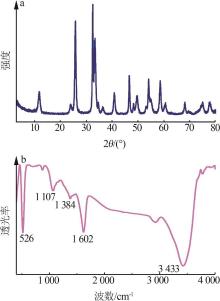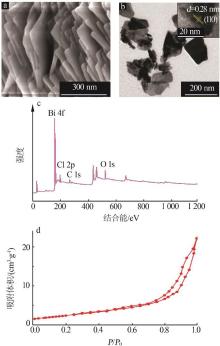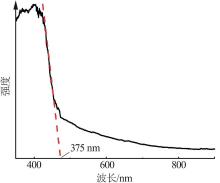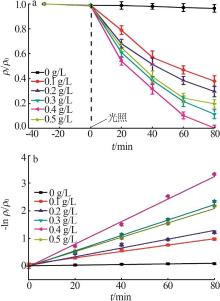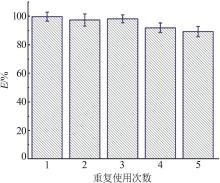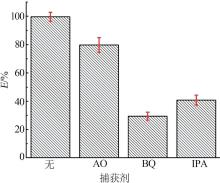| [1] |
WANG Ying, YANG Chuanxi, LIU Yonglin, et al.Solvothermal synthesis of ZnO nanoparticles for photocatalytic degradation of methyl orange and p-nitrophenol[J].Water,2021,13(22).Doi:10.3390/w13223224.
doi: 10.3390/w13223224.
|
| [2] |
孙鹏,柳佳鹏,王维大,等.活性炭强化热活化过硫酸盐降解对硝基苯酚[J].中国环境科学,2020,40(11):4779-4785.
|
|
SUN Peng, LIU Jiapeng, WANG Weida, et al.Active carbon enhanced thermal activation of persulfate for degradation of p-nitrophenol[J].China Environmental Science,2020,40(11):4779-4785.
|
| [3] |
何亚萍.纳米金对对硝基苯酚的降解行为研究[J].环境保护科学,2018,44(1):61-65.
|
|
HE Yaping.Degradation behavior of nanogold towards nitro phen⁃ol[J].Environmental Protection Science,2018,44(1):61-65.
|
| [4] |
夏丞垚,陈琼珍,沈文静,等.对硝基苯酚的生物降解研究进展[J].生物加工过程,2021,19(4):387-395.
|
|
XIA Chengyao, CHEN Qiongzhen, SHEN Wenjing, et al.Advancement inmicrobial degradation of Para⁃nitrophenol[J].Chinese Jo⁃urnal of Bioprocess Engineering,2021,19(4):387-395.
|
| [5] |
DENG Fang, ZHANG Qian, YANG Lixia, et al.Visible⁃light⁃responsive graphene⁃functionalized Bi-bridge Z-scheme black BiOCl/Bi2O3 heterojunction with oxygen vacancy and multiple charge transfer channels for efficient photocatalytic degradation of 2-nitrophenol and industrial wastewater treatment[J].Applied Catalysis B:Environmental,2018,238:61-69.
|
| [6] |
KADAM V V, SHANMUGAM S D, ETTIYAPPAN J P, et al.Photocatalytic degradation of p-nitrophenol using biologically synthesized ZnO nanoparticles[J].Environmental Science and Pollution Research,2021,28(10):12119-12130.
|
| [7] |
王丽,刘进,师兆忠,等.溶剂热法制备CdS@g-C3N4复合材料及其催化性能研究[J].工业水处理,2021,41(1):38-42.
|
|
WANG Li, LIU Jin, SHI Zhaozhong, et al.Preparation of CdS@g-C3N4 by solvothermal method and its catalytic performance[J].Industrial Water Treatment,2021,41(1):38-42.
|
| [8] |
王晨鑫,陈美丽,田蒙奎,等.镂空α-氧化铁纳米带制备及其光催化性能研究[J].无机盐工业,2021,53(6):185-189.
|
|
WANG Chenxin, CHEN Meili, TIAN Mengkui, et al.Study on preparation of hollow α-Fe2O3 nanobelts and their photocatalytic properties[J].Inorganic Chemicals Industry,2021,53(6):185-189.
|
| [9] |
黄夏梦.光催化材料Bi4O7/BiOBr的制备及其光催化性能研究[J].无机盐工业,2021,53(4):112-116.
|
|
HUANG Xiameng.Preparation of photocatalytic materials of Bi4O7/BiOBr and study on their photocatalytic performance[J].Inorganic Chemicals Industry,2021,53(4):112-116.
|
| [10] |
LIU Haijin, DU Cuiwei, LI Meng, et al.One-pot hydrothermal synthesis of SnO2/BiOBr heterojunction photocatalysts for the efficient degradation of organic pollutants under visible light[J].ACS Applied Materials & Interfaces,2018,10(34):28686-28694.
|
| [11] |
ARTHUR R B, BONIN J L, ARDILL L P, et al.Photocatalytic degradation of ibuprofen over BiOCl nanosheets with identification of intermediates[J].Journal of Hazardous Materials,2018,358:1-9.
|
| [12] |
LI Shijie, CHEN Jialin, LIU Yanping, et al.Insitu anion exchange strategy to construct flower⁃like BiOCl/BiOCOOH p-n heterojunctions for efficiently photocatalytic removal of aqueous toxic pollutants under solar irradiation[J].Journal of Alloys and Compounds,2019,781:582-588.
|
| [13] |
LIU Juanjuan, CHEN Lingze, ZHANG Suling, et al.Visible⁃light photoactive BiOCl nanosheets prepared by a solution chemistry method[J].Materials Letters,2018,233:174-176.
|
| [14] |
GAO Xiaoya, PENG Wen, TANG Guangbei, et al.Highly efficient and visible⁃light⁃driven BiOCl for photocatalytic degradation of carbamazepine[J].Journal of Alloys and Compounds,2018,757:455-465.
|
| [15] |
ALI M E M, ASSIREY E A, ABDEL-MONIEM S M, et al.Low temperature⁃calcined TiO2 for visible light assisted decontamination of 4-nitrophenol and hexavalent chromium from wastewat⁃er[J].Scientific Reports,2019,9.Doi:10.1038/s41598-019-55912-2.
doi: 10.1038/s41598-019-55912-2.
|
| [16] |
HASAN I, SHEKHAR C, SHARFAN I I BIN, et al.Ecofriendly green synthesis of the ZnO-doped CuO@Alg bionanocomposite for efficient oxidative degradation of p-nitrophenol[J].ACS Omega,2020,5(49):32011-32022.
|
| [17] |
HUANG Jingwen, JIN Bo, LIU Huiqiang, et al.Controllable synthesis of flower⁃like MoSe2 3D microspheres for highly efficient visible⁃light photocatalytic degradation of nitro⁃aromatic explosives[J].Journal of Materials Chemistry A,2018,6(24):11424-11434.
|
| [18] |
ZHANG Guangshan, HU Limin, ZHAO Renbo, et al.Microwave⁃assisted synthesis of ZnNiAl⁃layered double hydroxides with calcination treatment for enhanced PNP photo-degradation under visible⁃light irradiation[J].Journal of Photochemistry and Photobiology A:Chemistry,2018,356:633-641.
|
| [19] |
LU Xiaoying, CHE Wenjie, HU Xiufeng, et al.The facile fabrication of novel visible⁃light⁃driven Z-scheme CuInS2/Bi2WO6 heterojunction with intimate interface contact by in situ hydrothermal growth strategy for extraordinary photocatalytic performan⁃ce[J].Chemical Engineering Journal,2019,356:819-829.
|
 ),LI Siqi,FAN Fangfang,ZUO Weiyuan(
),LI Siqi,FAN Fangfang,ZUO Weiyuan( ),SHI Bingfang
),SHI Bingfang
